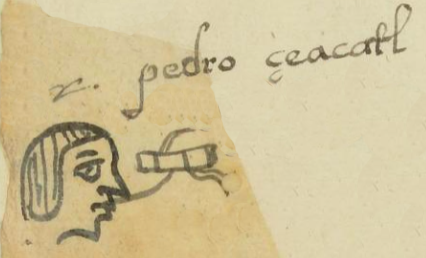Ce Acatl (MH558v)
This black-line drawing of the simplex glyph for the personal name Ce Acatl (“One-Reed,” attested here as a man’s name) shows a horizontal, segmented cane (acatl) with two small leaves coming off of it.
Stephanie Wood
Acatl is both a day and a year sign in the calendar. The ce (one) numerical coefficient that is mentioned in the gloss does not appear in the glyph unless it is implied in the single reed shown. But the earlier glyphs for One-Reed would have had a small circle to indicate the number/notation. By 1560, when this manuscript was made, calendrical names were losing their numbers. This could have been owing to a suppressive force of the colonial context, where there was concern among the clergy that people were still naming their children according to the divinatory codices and preserving original Indigenous beliefs and practices. Or it could have been an effect of self-censoring, or even forgetting the old system. Below are some examples of calendrical names that are missing their numbers (e.g. Calli) and one where the number is either glossed incorrectly or drawn incorrectly. Calendrics were an important element in the Nahuas' religious view of the cosmos.
Stephanie Wood
pedro çeacatl
Pedro Ce Acatl
Stephanie Wood
1560
Jeff Haskett-Wood
plants, plantas, reeds, cañas, dates, fechas, calendarios, ones, unos, xiuhpohualli, año, turquesa, xihuitl

ce, one, https://nahuatl.wired-humanities.org/content/ce
aca(tl), reed or cane, https://nahuatl.wired-humanities.org/content/acatl
Uno Caña, 1-Caña
Matrícula de Huexotzinco, folio 558v, https://www.loc.gov/resource/gdcwdl.wdl_15282/?sp=196&st=image
This manuscript is hosted by the Library of Congress and the World Digital Library; used here with the Creative Commons, “Attribution-NonCommercial-ShareAlike 3.0 License” (CC-BY-NC-SAq 3.0).







